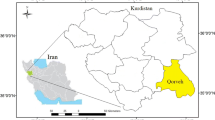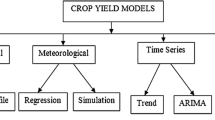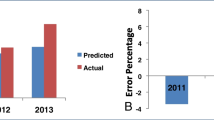Abstract
Weather models are essential tools for checking of the effect of the weather elements in terms of their effect on the production of the crop. This research is an attempt to see the effect of only two variables i.e., temperature and rainfall for the division Faisalabad (semitropical region of Pakistan).
The model fitted is of the linear form:Y=a+bX 1+cX 2, the values ofa,b,c have been found. The expected yield has been calculated by using the aridity indicesX 1 andX 2 and the result in the form of coefficient of determinationR 2 has been found equal to 0.166. The significance of the regression coefficient has been tested, which shows that the contribution to the yield from aridity index at germination and that at ripening is significant.
The wheat yields are the results of a wide variety of variables, most of which show varying degree of relationship with one another, some positive and some negative in terms of output. These variables may be technology, fertilizers, pesticides, epidemics, kinds of seeds used, market price of crop and the area under cultivation etc, which can be the source of variation in the wheat yield. Since rainfall during germination and temperature at the ripening periods are the necessary factors for the yield of wheat, for this purpose these parameters have been studied in order to their contribution.
Similar content being viewed by others
References
Coffing A. (1973), Forecasting wheat production in Turkey, foreign Agricultural Econnmic Report 85, the U.S. Dept. of Agri., Economic Research Services, pp 18.
Gangopadhyaya, M. and R. P. Sarkar (1965), Influence of rainfall distribution on the yield of wheat crop,Agri. Meteorol. 2, pp. 331–350.
Lomas (1972), Economic significance or dry land farming in the arid northern Neger of Israel,Agric. Meteorology 10: pp. 383–392.
Mc Quigg, J. D. (1975),Economic impact of weather variability, University of Missouri Columbia, Dept. of Atmospheric Science, 256 pp.
Thompson, L. M. (1962), Evaluation of weather factors in the production of wheat in the United States,Jour. of Soil and Weather Conservation,17:, pp. 149–156.
Thompson L. M. (1969), Weather and Technology in the production of wheat in the United States,J. Soil and Weather Conservation,24: pp. 219–224.
Thompson, L. M. (1969b), Weather and Technology in the production of corn in the United States corn belt,Agron. J., pp. 453-456.
Thompson L. M. (1970), Weather and Technology in the production of Soybeans in the central United States,Agron. J., pp. 232-236.
Salimi, M. A., G. Nabi and F. Muhammad (1988), Rainfall probabilities, Abstracts 1st Islamic Countries Conference on Statistical Sciences, Lahore, pp-58.
Author information
Authors and Affiliations
Rights and permissions
About this article
Cite this article
Haider, S.F., Asif, K.H. & Gilani, A.H. Weather yield model for the semi tropical region (Pakistan). Adv. Atmos. Sci. 9, 367–372 (1992). https://doi.org/10.1007/BF02656947
Received:
Revised:
Issue Date:
DOI: https://doi.org/10.1007/BF02656947




